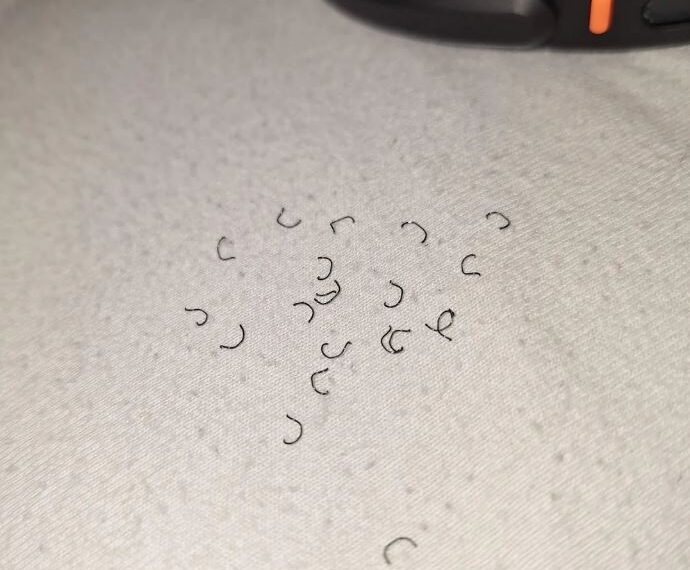Have you ever noticed tiny, curved, Velcro-like shavings mysteriously appearing on your desk, your bed sheets, or even on your wrist after removing your smartwatch or fitness tracker? At first glance, these little shavings look like miniature Velcro hooks. But if you don’t own any Velcro nearby, you might wonder — where do these shavings come from?
For many, the presence of these odd little fragments sparks curiosity and even concern. Are they some kind of dirt? Are they hazardous? Do they come from your watch or something else? Let’s uncover the truth behind these strange Velcro-like shavings, why they appear, and what you can do to prevent them.
The Mystery of the Velcro-Like Shavings: Where Do They Come From?
One of the most common culprits behind these Velcro-like shavings is likely something you wear every day: your smartwatch or fitness tracker band. If your device uses a silicone or rubber strap, then the tiny curls you see are probably small bits of degraded strap material.
The explanation lies in simple everyday physics and wear: friction, sweat, and repeated movement gradually break down the material of your band. Think of it like a busy road: just as a heavily trafficked street gradually wears down and accumulates dust and debris at the edges, your watch band’s material slowly erodes due to constant use and contact — shedding tiny fragments resembling Velcro hooks.
This is why those little shavings mysteriously show up on your desk, your bed, or your skin, often without you realizing their origin at first.
What Causes the Velcro-Like Shavings?
Several factors contribute to the breakdown of smartwatch and fitness tracker bands, accelerating the appearance of those tiny shavings.
1. Daily Wear and Tear
Constant twisting, flexing, putting on, and taking off your watch can cause micro-damage to the silicone or rubber material. Over time, this repetitive motion causes the material to degrade and flake off in tiny curls. The more you wear your device and the more active you are with your wrist, the faster the band ages.
2. Sweat and Skin Oils
During workouts or simply from daily skin oils, sweat accumulates beneath your watch band. This moist, warm environment can weaken the material over time, making it more prone to flaking. The oils your skin produces also degrade the band’s surface integrity, especially if it’s not cleaned regularly.
3. Friction from Desks and Clothing
Resting your wrist on a desk while typing or having long sleeves rub against the band increases friction. This constant rubbing wears down the material and leads to more Velcro-like shavings. Wearing tighter clothing that presses against your watch strap will also speed up wear.
4. Quality of the Band Material
Not all watch bands are made equal. Higher quality materials, such as fluoroelastomer, tend to be more durable and resist degradation longer. In contrast, cheaper silicone or rubber bands often break down faster, shedding more shavings. The quality of your band significantly impacts its longevity and shedding frequency.
Should You Panic About These Velcro-Like Shavings?
The good news is that these tiny shavings are harmless and not a sign of damage to your smartwatch itself. They simply indicate your band is aging and shedding its surface material.
However, if you notice any skin irritation, redness, cracking, or excessive flaking around the band area, it’s a good sign that the band has deteriorated enough to cause discomfort. In this case, it’s time to replace your band to avoid irritation or possible allergic reactions.
In many ways, the appearance of these Velcro-like shavings is nature’s way of telling you your band has served its time and needs upgrading.
How to Prevent the Mystery of Velcro-Like Shavings from Happening
If you want to minimize shedding and extend the life of your smartwatch band, there are several practical steps you can take:
1. Keep Your Band Clean
Sweat and skin oils accelerate wear, so rinsing your band regularly with mild soap and water is crucial. Cleaning removes sweat buildup and oils that break down the material. Aim to clean your band daily or after workouts.
2. Alternate Between Bands
Using the same band every day causes it to wear out faster. Consider having multiple bands to switch between. Rotating your bands allows each one to rest and dry fully, reducing constant friction and sweat exposure on a single band.
3. Reduce Unnecessary Friction
Be mindful of how often your wrist rests on hard surfaces like desks, and how snug your sleeves are over the band. Looser clothing or wrist placement adjustments can cut down wear from friction.
4. Invest in High-Quality Replacement Bands
If you need to replace your band, choose one made from more durable materials, like fluoroelastomer or high-grade silicone. These bands last longer, shed less, and tend to be more comfortable for all-day wear.
The Bottom Line: Understanding and Accepting the Shedding
Those tiny Velcro-like shavings might seem strange or concerning at first, but they are a normal byproduct of wearing a smartwatch or fitness tracker with silicone or rubber straps daily.
Their presence is simply a sign of normal material degradation caused by friction, sweat, and daily movement. When you start noticing these shavings more frequently, it’s a good idea to examine your band for signs of wear and tear.
Swapping out your band at appropriate intervals will keep your watch looking fresh and your wrist comfortable. The mystery of Velcro-like shavings is easy to solve — regular maintenance and timely replacement are key.
Bonus Tips: Caring for Your Smartwatch Band
- Avoid Exposure to Harsh Chemicals: Sunscreen, lotions, and cleaning products can damage the band material. Apply such products first and let them dry before putting on your watch.
- Dry Your Band Thoroughly: After workouts or washing, dry your band completely before wearing it again to avoid moisture buildup.
- Store Bands Properly: If you remove your band for a while, keep it in a cool, dry place away from direct sunlight to avoid premature aging.
Final Thoughts
The next time you find tiny Velcro-like shavings on your bed, desk, or wrist after removing your watch, you’ll know exactly what they are and where they came from. This harmless sign of wear is a small price to pay for the convenience and functionality of your smartwatch or fitness tracker.
Taking proper care of your watch band can prolong its life and keep your skin happy. And when the time comes, replacing the band with a durable, high-quality option will ensure your wrist stays comfortable and your device looks great.





